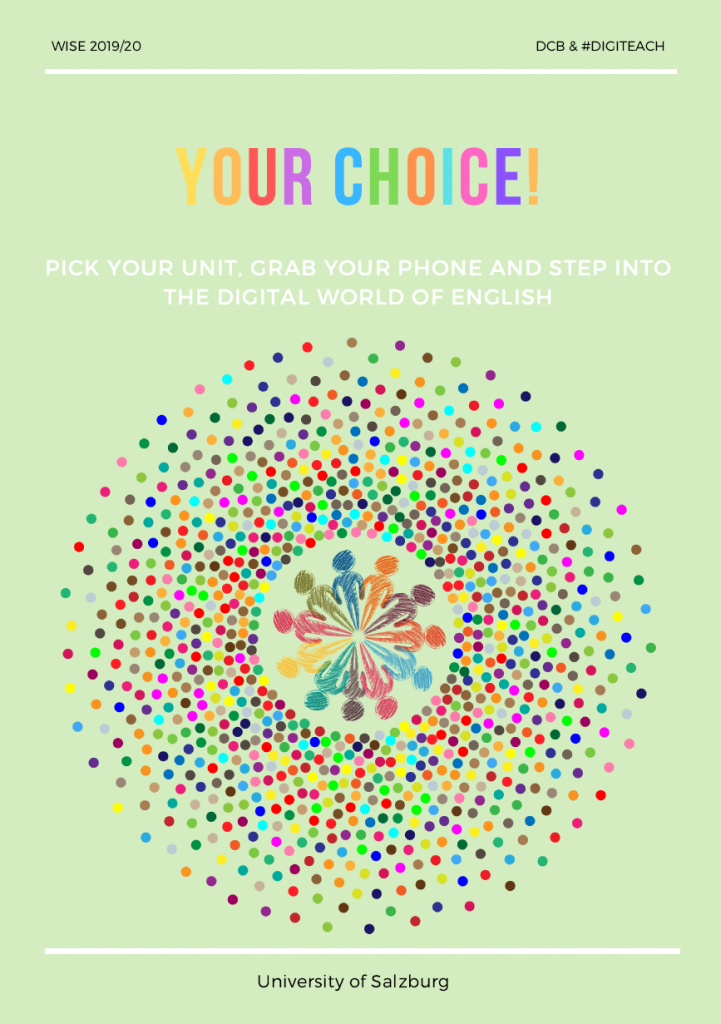Trainee teachers in the University of Salzburg have been designing and creating their own Teaching English as a Foreign Language (TEFL) courses using a variety of different approaches which includes the extensive use of digital tools and resources.
The Product

The e-booklet Your Choice!, published under a Creative Commons CC BY-SA 4.0 license (available here ), is the collaborative outcome of two TEFL (Teaching English as a Foreign Language) courses in the teacher education programme at the University of Salzburg, Developing Coursebooks (Tanja Greil) and #digiteach (Julia Weißenböck). All the materials which are part of this e-booklet were produced by 22 students who took the courses in the winter term 2019/2020 and the final editing was done in spring 2020.
The process
At the beginning of our courses, we informed our participants about the overall goal: an e-booklet for teenage learners of English at pre-intermediate level to which each team of two students contributes one unit. In setting this goal, our teacher trainees should get the opportunity to make use of their TEFL competences and acquire new competences in digital learning materials.
In the first phase, we provided participants with the necessary background knowledge. In Developing Coursebooks, the students gained insights into the development process of professional materials in language teaching and they received guidelines for the unit structure and requirements. In #digiteach the students were introduced to different theories and frameworks, in particular the 4Cs (Creativity, Communication, Collaboration and Critical Thinking) and got to know a range of different digital tools and apps for teaching English. Both groups also received detailed information on copyright laws and Creative Commons licenses.
In the following and longest phase, we organised teams across courses, so they could benefit from each other’s expertise. Each team (of 2 students) was responsible for one unit. In this process the students produced all the content on their own: they created explainer videos, they filmed role plays, they produced their own podcasts, made vox pop interviews or wrote blog posts etc. For each input, they designed tasks for which they also made use of a variety of digital tools.
We, the course teachers, monitored this rather complex process closely. We gave advice and feedback, fed in ideas or organised peer exchanges.
In the final phase, we supervised the final editing process and a layout team invested a lot of time making the booklet look professional. Even though there was considerable time pressure towards the end, the students managed to present their outcomes at an end-of-term student conference.
The benefits for learners of English (and their teachers)
The e-booklet Your Choice! and its digital components represent an extensive and up-to-date resource offering a variety of materials. Learners can choose from 11 Units on different topics and train different communicative competence areas (working with topic-related vocabulary, reading, listening/watching, speaking, writing) and various aspects of the 4Cs. As each unit is self-contained, learners can pick and choose according to their interests. They simply click on the link and download the booklet as a whole or individual units to their computer, laptop, tablet or mobile phone. QR codes and hyperlinks in the booklet provide easy access to videos, audio files and all the other digital tools used; learners do not have to register or log in for any of the tasks.
Generally, the booklet can be used in various teaching and learning scenarios: in class or individually outside the classroom, but it would certainly work best in open learning settings in which two students decide to work on the same unit and their teacher monitors. This way learners can act autonomously and take responsibility of their own learning. In the end, we hope that users of this e-booklet will appreciate material that is refreshingly different from commercially produced coursebooks, if not always perfect. It is an e-booklet made by students (at university) for students (at secondary school).
The benefits for teacher trainees as materials’ designers (and as course teachers)
The teacher trainees who design their own unit while keeping the overall product in mind learn a lot about the complexity of materials development processes. A learning-by-design approach is a great opportunity for teachers to be part of a creative process and use all the TEFL-related competences they have acquired in their studies. At the same time, they learn to reflect on how and when to use digitals tools and apps effectively in language teaching.
In this teaching project, we wanted to set an example for collaboration in higher education. We also intended to show how teacher training programmes could shift their focus towards a more project-oriented approach in which students can combine and train various skills at once (e.g. 21st Century Skills, digital & teaching competences). We consider this kind of teaching project a good preparation of teacher trainees for the demands of teaching in today’s world and we plan to do more projects of this kind in the future.
Editor’s Note: Tanja and Julia will be presenting at a seminar on “Media-supported Language Teaching” on Thursday 17 February, find out more and register here.

Authors
Dr. Tanja Greil, Lecturer of TEFL at the Department of English and American Studies, University of Salzburg, Austria

Mag. Julia Weißenböck, MSc, BA, Lecturer of TEFL at the Department of English and American Studies, University of Salzburg, Austria














